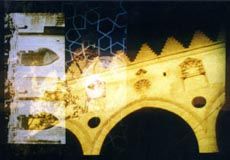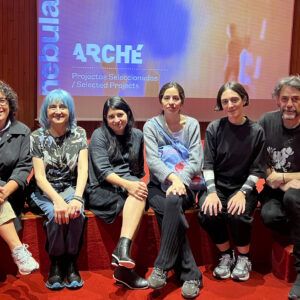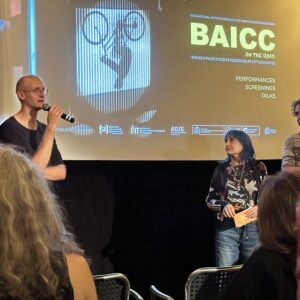Down below we share with you an excerpt of the interview Especies de espacios with Deborah S. Phillips made by Francisco Algarín Navarro for Lumière, where they discuss the creative process of her monumental and hallucinating film Mosaïc.
What was the relationship between your travels and your decision to make Mosaïc?
In 1996 I was part of an institutional collective of German artists who were touring around Central Asia. We traveled for six weeks, and in that span of time we showed our films in Kazakhstan, Kyrgyzstan, Turkmenistan, and Uzbekistan. While we were on tour, I had to attend many official receptions, more than five per day! Many things felt familiar, especially that which had to do with what I knew from European Jewish heritage. I think this is what led me to imagine Mosaïc as a film project.
In Andalusia, for example… I didn’t have my film camera with me. I visited the region with a bunch of friends who were also draftsmen. We made some frottages and took a few pictures with my loyal Pentax, which I bought in 1981. However, at first, I thought that not many people, except for some architect friends (there were a few architects traveling with us, too) showed interest in the project, and I felt the same about the team of Legado Andalusí, which helped me a lot in the end.
The structure for Mosaïc was very clear in my mind from the beginning. Very soon, I knew I wanted it to be divided into chapters. I imagined the film as some sort of moving book with music playing along. For the last phase, I collaborated with my friend Sala Deinema, who had worked as an editor for several films. I just needed some help with the practical aspects. For someone who has a creative mind and wants to explore different possibilities… struggling with the technical part can be very frustrating.
*
How did you manage to combine several formats in a single film, as you did in Mosaïc?
Well, in Mosaïc there are three coexisting formats probably because I filmed in many locations, which wasn’t the case with my previous films. In this case, I animated the footage I had filmed with the Bolex and the Pentax using a 35mm Crass camera. When I visited Iran, for instance, I decided to travel with my super 8 Nizo camera, because I didn’t want the filming process to be that serious. At the same time, I didn’t like the idea of people staring at me the whole time, wondering what I could possibly be doing. Then, when I printed the film with the Crass, what I did was film the film strip. That way, the texture turned increasingly blurry due to the lighting conditions, which also modified the image and increased the contrast. As for the footage I filmed in Andalusia (which, as I said, consisted mainly of frottages and pictures), I also animated it with my 35mm Crass camera. And with my 16mm Crass camera, the one I use here in Berlin, I animated several objects –I set them on the table and then projected the footage I had filmed with the Bolex.
You have already explained how you use your Crass camera, but could you elaborate on your creative processes and technical procedures when you work in 35mm?
Not all Crass cameras allow you to work that way, not even all the cameras produced by the company… but I’ve been able to do it with my two Crass cameras, both the 35mm one (the one we had in Braunschweig) and the 16mm one, which is now at the LaborBerlin headquarters. The process looks like some sort of aerial projection. I work from the material I’ve filmed and processed (sometimes I’ve done it with found footage, too, which is not something I frequently do, but it’s a common practice of some artists with whom I collaborate). In Braunschweig I used a 35mm camera, which allowed me to use slides or collage techniques onto slide frames. This is the case with films like Santoor, Mosaïc, and the trailer of Blue Note. What I did was project the images onto a special mirror that brought the images together. This mirror was placed at an angle of 45º in relation with the table or platform on which I created the animations. When the whole setup was ready (which isn’t easy to achieve; finding the right position can take me days, and if something moves you need to readjust it), I placed several field lenses on a square cavity in the animation table. Those lenses are bigger than an A3 sheet, and they’re quite heavy, too). Little by little, the images are brought together and converge on the lenses, allowing you to create animations with objects, or with your own hands. You can do anything on those lenses. Meanwhile, the camera is hanging from the ceiling, and it is connected to a control panel that, through a series of electric impulses, tells the camera what frames to film. There’s a secondary control panel for the projector, which is placed on the floor, so that we can order it to show one frame at a time.
I used this method for creating animations in several of my films. Recently I’ve spent six months working on the configuration of this setup. I can use it alone or with the help of other people. One person would stand on the ladder, checking what the camera is capturing. A second person would be in charge of supervising the projector, moving it forward millimeter by millimeter towards the projected image, which is visible on camera. This is how it works. Sometimes it doesn’t fit completely, like in Nach Osten Schauen. In LaborBerlin, for example, there are many fellow artists entering and leaving the place all the time… so the image is never 100% adjusted, and this creates a prism-like effect at the bottom edge of the projected image.






